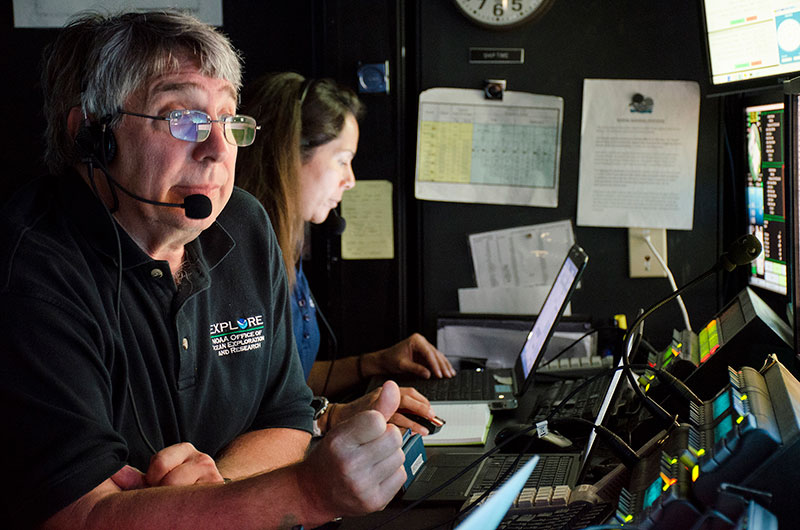
by Nikola Rodriguez, Intern, NOAA Educational Partnership Program
August 1, 2017

Expedition science leads, Dr. Chris Kelley and Dr. Chris Mah, and NOAA EPP Intern, Nikola Rodriguez, pose for a picture while standing by waiting to receive word that the ROV is secured on deck and it is safe for them to go retrieve samples collected during the day’s ROV dive. Image courtesy of Nikola Rodriguez. Download larger version (jpg, 265 KB).
When I first arrived on the Okeanos Explorer, people would ask, “Are you the ‘intern’?” I would politely say, “yes” and smile. Followed by, “What are you going to be doing on the ship?” Honestly, I was not sure what exactly I would be doing.
Before I arrived onboard, I spent five weeks working with the NOAA Office of Ocean Exploration and Research in Silver Spring, Maryland, reviewing video annotations from past expeditions and learning about mapping data products. But this immersive experience onboard the Okeanos was much more than interacting with the video and mapping data. I was helping create it.
Soon all of the puzzle pieces started settling in and I had a blast on the ship working with the different teams learning remotely operated vehicle (ROV) and mapping operations and taking part in sample processing and video annotations. I walked away with a deeper perspective of the hard work that the Okeanos Explorer crew puts in to bring live video to scientists and the public.

NOAA EPP Intern, Nikola Rodriguez, gets ready to deploy the Expendable Bathythermograph (XBT) off the aft deck of NOAA Ship Okeanos Explorer. XBTs are launched every ~2-6 hours to acquire temperature data of the water column down to 760 meters (2,493 feet). These data are used to estimate water column refraction required for multibeam sonar data. Image courtesy of Nikola Rodriguez. Download larger version (jpg, 235 KB).

NOAA EPP Intern, Nikola Rodriguez, and NOAA's National Centers for Environmental Information Data Manager, Matt Dornback, process biological specimens collected during an ROV dive. Image courtesy of the NOAA Office of Ocean Exploration and Research, 2017 Laulima O Ka Moana. Download larger version (jpg, 55.8 KB).
So, how did I get on the Okeanos Explorer as a NOAA intern? I’m an undergrad from the University of Hawai’i at Hilo pursuing a B.S. in Marine Science with a minor in Chemistry. This year, I was one of eight recipients of the NOAA Educational Partnership Program (EPP) Scholarship. The scholarship provides recipients two years paid tuition and two paid summer internships in a NOAA office. During the first internship, all recipients intern at NOAA headquarters in Silver Spring with a participating office.
While skimming the available internship opportunities, I came across a posting to intern with the Office of Ocean Exploration and Research (OER) working on ROV video annotation with the small chance of getting on the Okeanos Explorer during their next expedition!!! As a scientific diver for the University of Hawai’i, I was instantly drawn to working on the ship and with ROV video and annotation data. The OER internship quickly became my first pick and I was fortunate enough to be selected for the OER internship and being able to participate in the expedition was almost my dream come true.
My first days on the ship were a little intimidating, to say the least. All these brilliant people were on board with a known purpose and I was the “intern,” still waiting to learn and understand my job. After I settled in and started getting to know all the amazing people on board, I decided to offer my help where I could.

Onboard science lead Dr. Chris Kelley and NOAA EPP Intern Nikola Rodriguez discuss and take a closer look at deepwater habitats explored with ROV Deep Discoverer on Horizon Guyot. During the cruise, Nikola logged scientific observations during ROV dives and analyzed these annotations for a final project. Image courtesy of the NOAA Office of Ocean Exploration and Research, 2017 Laulima O Ka Moana. Download larger version (jpg, 1.9 MB).
The mapping team taught me how the multibeam sonar works and I assisted them with data processing and conducting XBT casts (required for refraction corrections for multibeam sonar). Once the ship arrived in the Johnston Atoll area and started conducting ROV dives, the science leads Dr. Chris Kelley and Dr. Chris Mah took me under their wings. Not only did I get to sit in the control room logging annotations with their help during the dives, I was also able to help with processing all the specimens that we collected during the dives. The anticipation of touching potential new species as we recovered specimens from ROV sample box was itself a once in a lifetime opportunity.
Throughout the cruise, I got more experience than I could ever dream of on my first internship. The connections I made with the people on board the ship and the experience I got through this internship is invaluable. I am even more driven to get back on a NOAA ship, hopefully the Okeanos Explorer, in the future and continue my career in marine science.